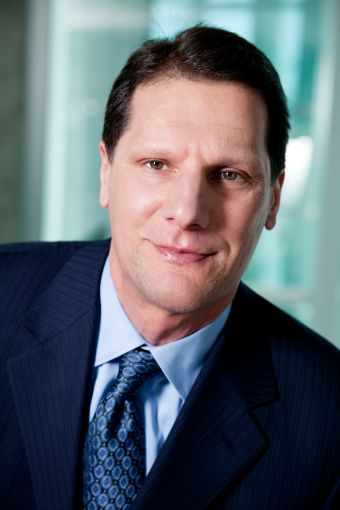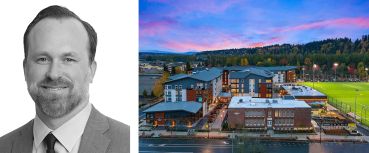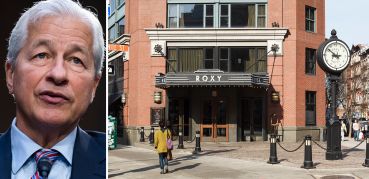Q&A: Michael Maturo, President and Chief Financial Officer at RXR Realty
By Danielle Balbi May 4, 2016 5:51 pm
reprints
RXR Realty is undoubtedly on fire. In the first few months of 2016 alone, the Long Island-based real estate firm attained a $225 million construction loan to transform the historic Pier 57 on the West Side into a $350 million office, retail and park destination. Almost a month later, in late April, the firm sold a 49 percent stake in 61 Broadway in the Financial District to China Orient Asset Management and landed $290 million in debt from Bank of China and SL Green Realty Corp. for the office property’s recapitalization. Spearheading these deals is Michael Maturo, the president and chief financial officer at RXR, and his team of 60 finance and asset management experts. Mr. Maturo sat with Commercial Observer in the company’s 1330 Avenue of the Americas offices and discussed everything, from how he first became Scott Rechler’s partner to RXR’s plans to bring in an undisclosed foreign investment partner on the recently purchased 1285 Avenue of the Americas. Mr. Maturo also provided insight into the inner workings of the real estate company that has continued to make a huge play in the tri-state area.
Commercial Observer: How did you get into the industry?
Mr. Maturo: [In 1983] I started with a firm called Kenneth Leventhal & Company, which was a real estate consulting and auditing firm. It had a very boutique-type of service and catered solely to real estate businesses. It was interesting in that the projects were very unique, ranging from understanding and helping people with development, to helping developers and operators through the workout environment. It was also focused on working on large projects, financial structuring and tax structuring, and providing audit and tax services to those real estate clients. I learned a lot about real estate there for 10 years or so. Then we merged with Ernst & Young, and it became EY Kenneth Leventhal for a number of years.
So how did you meet Scott Rechler, chairman and chief executive officer at RXR?
When Scott was doing his [initial public offering for Reckson Associates Realty Corp.], I had been working on a number of [real estate investment trust] initial public offerings in the early 1990s. Scott started his IPO in late 1994 and closed at the beginning of 1995. In December of 1994, he contacted me through an investment banker about becoming his CFO—being the first non-family member to come into the executive ranks. I had dinner with him, his wife and my wife, and we hit it off pretty quickly. I decided, long-term career-wise, I wanted to get on the investment side. We worked together over the years to build a public company, aggressively grew it throughout the tri-state area and then into Manhattan and then expanded aggressively within Manhattan. We wound up selling the business to SL Green for over $6 billion. Then we quickly formed RXR, and we’ve been raising private capital ever since. And that’s how we fund ourselves—with funds, co-investments, joint ventures. So we’ve raised almost $6 billion since we formed RXR, and we’ve acquired about $15 billion of assets and expanded the company. We were about 300 people. When we sold Reckson we were down to about 100 or so people and kept our key execution team and our senior executives. Now we’re back up to over 400 people. It’s been quite a reestablishment of the company, expanding particularly in New York. We’re doing some interesting things in the suburbs—[it’s] what we call “urban-suburban,” which is focused on the downtowns of the suburban markets in New Rochelle and Yonkers.
As president and CFO, what exactly does your role entail?
I head up all the capital raising and spend a lot of time on corporate strategy, sales of assets, refinancings, recapitalizations and joint ventures. I have a pretty deep finance team and a really deep capital markets team.
How many people are on those teams?
On the capital markets team, there are about seven people, and then with accounting and asset management, there are about another 60 people. It’s a big group.
How many funds does RXR have?
Right now we have four funds. Our first fund was $250 million—with co-investment and separate account equity that number is probably around $2 billion of equity. Our second fund was $500 million, and we’re fully committed in that fund with co-invest and separate accounts there’s roughly $2.5 billion of equity. We’ve raised a $300 million emerging-submarket fund, [which is used to] invest in the boroughs and urban-suburban markets. And now we’re raising our latest fund—a value-added fund—between $1 billion and $1.5 billion, and [so far] we’ve closed about $600 million.
On the commercial side we’re doing a lot of redevelopment: 75 Rock is a big redevelopment; we did a big redevelopment at 237 Park; and then obviously Pier 57 is a major redevelopment.
A lot of people have been saying that it’s difficult to get construction financing given where we are in the cycle. What was the market’s reception to financing the Pier 57 deal?
I think there’s financing available in the market for good sponsors and good projects, and I think what’s most important is that you have to demonstrate to lenders that you have a sophisticated, deep infrastructure and a proven ability to execute.
Lenders are very willing to participate in projects that they get excited about like 75 Rock that’s well located around an iconic development like Rockefeller Center. If you look at Pier 57, which obviously is a very unique project, and look at what’s going on in that marketplace in terms of the Meatpacking [District] and all of the development on the West Side and being able to attract a tenant such as Google—you take those attributes along with RXR’s ability to pull everything together in terms of working with Hudson Property Trust, working with tenants and working with architects and engineers to design the building. You can get banks comfortable with providing financing.
You also just sold a stake in 61 Broadway and got $290 million from Bank of China and SL Green. What was the story there?
That [building] is in our second fund, which is fully committed. This is one of the earlier assets that we purchased and interestingly enough, what we’ve been good at is seeing the trends before they happen. We were early in Midtown South. We bought the Starrett-Lehigh Building and we bought 620 [Avenue of the Americas] before Midtown South got going. It was kind of the same thing Downtown. Three or four years ago it was still going through construction, dealing with security issues and all of the transportation that was being developed. We saw that [this development] was going to mean good things. We saw a lot of residential development going Downtown.
What we also saw was that Midtown South needed a relief valve because the market was so tight there and rents were accelerating. Where was the next natural movement for those creative-class type tenants? In fact, we were seeing tenants move from our Starrett-Lehigh Building down to 61 Broadway. Bjarke Ingels actually moved from Starrett-Lehigh Building to 61 Broadway. We saw that as a good indicator that this building had a certain feel to it that was appealing to that type of tenant. So we bought early before markets turned upward and were able to get into that building at a very good basis.
As this fund starts to mature, it’s the first asset that we have sought to monetize. We sold a 49 percent interest in the building to China Orient [Asset Management], but we didn’t sell the whole building because we still think there’s another level of value creation to be made. We’re going to continue to turn the tenant spaces and realize that second level of value along with our new partner.
Will the proceeds of the loan be used toward upgrading those tenant spaces?
Yes, some of the improvements and upgrades that were planned, and then obviously we’re able to return capital to our investors with sizable returns.
Are there any other deals you were really excited about this year?
We’re excited about 1285 Avenue of the Americas, which again is another unique ability to get into a complex situation where you had the UBS lease that needed to be recast and had an expiration, and we had to go out and get financing in December, 2015 and January, which was a very difficult environment. But again, you had a high-quality asset with a high-quality tenancy with a great location and a first-class operator-sponsor. We’re doing that deal with AIG and Morgan Stanley who we’ve done many financings with and [they] had a high degree of comfort that we would be able to pull it all together in terms of getting the UBS lease done and getting the other leases adjusted.
We looked at CMBS there, and during that December, January period the CMBS markets were very volatile. We got bids on the CMBS sides but also through our relationships were able to do a bank loan, which we are very, very happy with.
There’s been a lot of moving parts. We’re bringing in a foreign institutional investor for 40 percent of the transaction—somebody we’ve been working with for the past year or so, and this will be our first joint venture. It’ll be one of the seed assets in our new fund.
It seems like your projects are getting excellent reception when it comes to financing. Why was this year the right time to enter the lending side?
We’ve actually been in the financing market ourselves since the time of Reckson, when we ran about a $500 million or $600 million book of [debt] business. That time it was mostly to develop relationships with owners so we would buy mezzanine pieces. It allowed us to become a partner with the owner, and when the building needed to be sold, we were in that catbird position to potentially buy the asset. In [RXR’s] first fund, we bought 450 Lexington Avenue. We [originally] bought a mezzanine position there, developed a relationship with Istithmar—who owned the asset—and when the time came that they needed liquidity, we negotiated a purchase of the equity there. Historically, that’s kind of the business we’ve been in.
Now, as we see the cycle, we think there’s going to be a lot of recapitalizations, and so we’re looking at situations where we can be a provider of that capital. By our understanding of real estate we can be more of a flexible lender, act with speed and be more additive to a project by having that operational experience. And because financing for construction has tightened up a little bit, there will be good projects that need to complete their capital stack, and we’ll be able to provide the capital that’s above the construction loan and below the equity.
So is it better to be a borrower or a lender right now?
We have the ability to operate projects, we have the ability to redevelop them, we have in-house capabilities in architecture, engineering and design. We have ground-up development expertise. In terms of how we match our investment with that infrastructure and all those capabilities, we feel that there’s a place where we can do ground-up development, there’s a place for our organization to do redevelopment, there’s a place where we’ll do core-plus investment and then there’s the lending aspect. We think there is a niche in that market where we can fill what we think is going to be a void. Banks have pulled back on providing construction financing or the level of construction financing that they’ll provide so we could provide a higher debt-to-cost layer. And we think that over the next couple of years, as a lot of debt comes due from the 2006 to 2008 era, that there’s going to be a shortfall in the amount of capital to refinance certain assets or portfolios and there will be a place for us to place some capital.
From our investor standpoint, there is an appetite for a more income-producing type of investment. Our investors are asking us to look for these opportunities also, so we just look at it as part of the product offering that we can provide to our institutional investors so they can invest with us in a ground-up development, they can invest with us in a redevelopment, and they can invest with us in more of a lending product. We’re trying to bring different products to our group of institutional investors. It allows them to build their own portfolio around us.
Have you started a fund specifically for your lending business now?
Our new fund will probably raise between $1 billion and $1.5 billion, and what we intend on doing is allocating a portion of that fund toward this lending recapitalization investment.
So what’s RXR’s lending appetite?
We’ll look at anything from $5 million to $500 million and what we intend on doing is allocating a portion of that fund towards this lending recapitalization investment.
The Extell [Development Company] deal we’re doing is $460 million. We won’t hold that all on our fund—we will have co-investments.
As far as multifamily goes, what are your thoughts? How much will the lapse in 421a stunt development?
The good news is that leading up to the expiration of 421a, there were a lot of projects that were put in the queue. Once those projects do get done, there may be a void, and obviously we need more affordable housing. The way we look at it, we think it’s a regional solution, not just a New York City solution. That’s why we’ve expanded our footprint in looking at places like Yonkers, New Rochelle, Glen Cove, Long Island and Stamford, Conn. Those places have walkable downtowns; they have the landscape, the streetscapes and the environment that young people want to be in, and they effectively provide affordable housing in comparison to New York. You’re looking at places where you can pay literally one-third or one-half of what you pay in Manhattan or Brooklyn. You’re talking about places that are only 30 minutes away from Grand Central, which is closer than some places in Brooklyn and Queens. It is a real viable alternative that we think, as urbanization continues, will become more and more a real and viable option.


